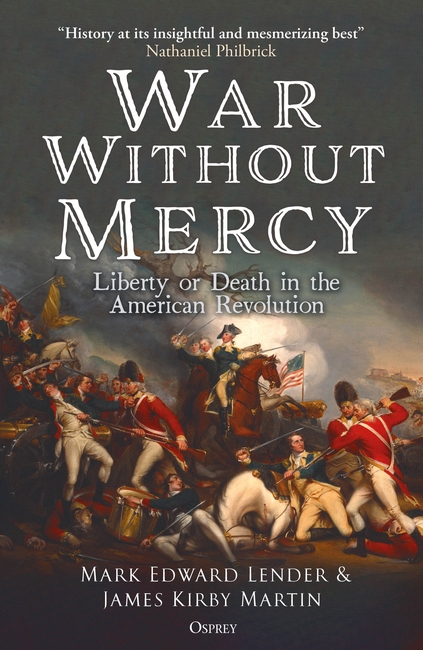
For over two centuries the American military narrative of the Revolution has favoured a relatively temperate view of the contest for independence – at least on the part of the winning patriot side. The nation’s founding myth dwelled largely on the nobility of the struggle and the heroic sacrifices of the revolutionary generation as it confronted and overcame British, tory, and American Indian depredations. A triumphal narrative emphasized what we might call a “revolutionary immaculate conception” – a victory wrought without patriots resorting to the hideous violence and horror associated with many subsequent revolutions. The French, Latin American, Russian, and Chinese revolutions represent cases in point. This perspective – a blind spot, actually – began with early historians sympathetic to the Revolution, including such accomplished writers as Carlo Botta, Mercy Otis Warren, and David Ramsay. Although perfectly willing to see patriots as victims of British malevolence, they scanted mention of any similar conduct among the revolutionaries.
For generations this generally benign perspective on the patriot war effort has prevailed in the popular narrative of the Revolution, and even among many academic historians. More recently, however, this view has been changing. With many whigs having seen Liberty or Death as literal alternatives – with no room for middle ground – much evidence of serious violence became all but inevitable once warfare erupted. Opinions have differed on the extent of the consequent ferocity of the fighting and who was most to blame. Among the closest students of the conflict there is now general agreement that combatants (especially those engaged in combat beyond the regular armies) showed little remorse or sympathy toward their opponents. Any number of accounts on the war in particular regions or in specific incidents also have found violence to be pervasive, with combatants often making few distinctions between soldiers and civilians. Places like Cherry Valley, New York; Augusta, Georgia; Monmouth County, New Jersey; Wyoming, Pennsylvania; Gowen’s Fort, South Carolina; New London, Connecticut; Gnadenhütten, Ohio; and so many others would see the blood of innocents and combatants alike shed with deliberate cruelty – along with racial strife, psychological shock, and incalculable property destruction. Tens of thousands would be driven from their homes as exiles and refugees. Such were the realities of the war, as many well-researched histories have concluded.
The incidents related in these studies comprise a catalog of horrors. As James Lovell had predicted, the rival combatants came to loath one another and “blind fury govern[ed]” their conduct. Patriots in particular had few scruples when it came to stifling royalist voices. Well before independence, whigs orchestrated local efforts to impugn the dignity and social standing of prominent loyalists. These were campaigns of character assassination, and in the honor-driven world of 18th-century elites, they frequently shattered the morale and political influence of their targets. From this it was an easy step toward harsher measures. In various protests against British policies, whigs openly threatened royal officials or anyone suspected of royalist sympathies with social ostracism and physical violence. Intimidation of suspected tories was commonplace, and tarring and feathering – a brutal torture – was the fate of more than a few individuals with courage enough to openly disagree with rabid patriots.9 And as T. H. Breen has thoroughly shown, much of this activity was the work of local ad hoc whig committees acting independently of and without the sanction of patriot elites – a precursor of how many local patriots later (and not too much later) would fight their war. Friends of the King lived at the sufferance of local activists, answerable only to themselves for their conduct.
Rebels did not shy away from employing outright terror. In late 1775, to cite a hideous example, a mob of Georgia patriots confronted loyalist Thomas Brown and insisted he pledge support for the rebel cause. When Brown refused, whigs fractured his skull with a rifle butt, tarred his legs, and held them over a fire. Then they cut of his hair, scalped him, and left him for dead. The patriot Georgia Council of Safety considered the matter something of a lark: “The said Thomas Brown is now a little remarkable, wears his hair very short, and a handkerchief around his head in order that his intellect … may not be affected.” The council would regret its levity. Brown – “Burntfoot” Brown ever after – lost two toes but recovered to become a talented guerrilla commander and scourge of southern patriots for the rest of the war.
Northern patriots were no more tolerant. In early 1777 at Morristown, New Jersey, patriots hanged two tories and the same day would have executed dozens of others had they not “volunteered” for service in the Continental Army. Fighting for “liberty” did not imply compassion for contrary opinions; revolutionaries were not (and usually are not) champions of free speech.
We could pile example upon example, but the pattern is clear: No one involved – patriot, loyalist, American Indian, or redcoat – had a monopoly on military excesses, which often rose to the level of atrocities and tore at the very social fabric. The lament of New Jersey pastor Nicholas Collin, who saw his congregation ripped apart by civil discord, captured the calamitous state of affairs: “Everywhere distrust, fear, hatred, and abominable selfishness were met with. Parents and children, brothers and sisters, wife and husband were enemies to one another.” The distraught pastor’s cry from the heart was the stuff of high tragedy.
There is a name for this kind of war. Historians have rarely applied it to the American War for Independence, but we will insist that it captures the essence of the revolutionary struggle. This is “existential warfare.”
Read more in War Without Mercy: Liberty or Death in the American Revolution.

Comments
You must be logged in to comment on this post. Click here to log in.
Submit your comment